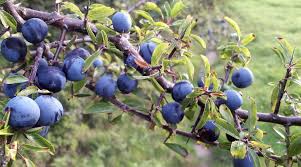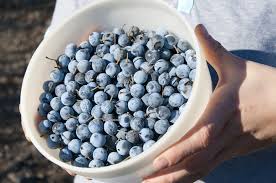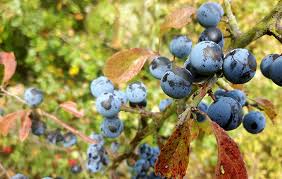Sloes, scientifically known as Prunus spinosa, are small dark-purple fruits that grow on the blackthorn bush. These tiny, round berries are commonly found in Europe and parts of Asia, delighting foragers and nature enthusiasts alike. The scientific name “Prunus spinosa” reflects its belonging to the Prunus genus, which includes other fruits like cherries and plums.
These little fruits pack a punch of flavor, with a unique tartness that sets them apart. Sloes are often used in culinary pursuits, particularly in the production of sloe gin, a popular alcoholic beverage. The distinctive taste of sloes adds a delightful twist to various recipes, making them a sought-after ingredient in jams, jellies, and desserts.
The blackthorn bush, the home of sloes, is characterized by its thorny branches and small white flowers that bloom in early spring. The berries themselves are relatively small, about a centimeter in diameter, and have a dark blue or purple hue. While sloes are not typically consumed raw due to their astringent taste, they become palatable after undergoing processes like freezing, cooking, or steeping.
One fascinating aspect of sloes is their historical and cultural significance. In some traditions, blackthorn bushes were believed to possess mystical properties, and sloes were considered protective charms. The folklore surrounding these berries adds an enchanting layer to their existence, connecting them to ancient beliefs and practices.
In addition to their culinary and cultural uses, sloes have also been explored for their potential health benefits. Some studies suggest that sloes may contain antioxidants and beneficial compounds, contributing to their potential positive impact on health. However, it’s essential to note that research in this area is ongoing, and sloes should be enjoyed as part of a balanced diet.
Sloes, scientifically identified as Prunus spinosa, offer a unique and flavorful addition to various culinary creations. From the historical mystique surrounding the blackthorn bush to the contemporary joy of savoring sloe-infused delights, these berries continue to captivate and inspire. Whether enjoyed in traditional recipes or modern concoctions, sloes showcase nature’s bounty in a tiny, delectable package.
Read Also: Best Age to Buy Ruminants for Raising
The History of Sloes

The history of sloes traces back through the centuries, weaving a tale of culinary uses, folklore, and cultural significance. Sloes, scientifically known as Prunus spinosa, have left their mark on different societies and traditions, contributing to a rich historical tapestry.
In ancient times, the blackthorn bush, home to sloes, was valued for more than just its fruits. The thorny branches and small white flowers that adorned the bush made it a symbol of resilience and adaptability in the face of challenging environments. Some cultures believed that blackthorn had protective qualities, and it was often planted as hedgerows to mark boundaries and provide natural barriers.
As societies evolved, the use of sloes in culinary endeavors became more pronounced. The distinctive tartness of the berries found its way into traditional recipes, especially in regions where blackthorn bushes flourished. Sloe-infused products, such as jams and jellies, became popular, showcasing the versatility of these tiny fruits in the kitchen.
One notable culinary application of sloes is the creation of sloe gin. This alcoholic beverage has a long history, with recipes dating back centuries. The process typically involves steeping sloes in gin along with sugar, creating a delightful and unique liqueur. Sloe gin has become a winter favorite, enjoyed as a warming drink with a hint of sweetness.
Beyond the kitchen, sloes have held a place in folklore and cultural practices. In some traditions, blackthorn bushes and sloes were believed to possess mystical properties. The berries were considered protective charms, and the folklore surrounding them added an element of magic to the natural world. These beliefs contributed to the cultural significance of sloes and their association with ancient customs.
In more recent times, there has been an increasing interest in the potential health benefits of sloes. Studies have explored the antioxidant content of these berries and their possible contributions to well-being. While the scientific understanding of sloes’ health effects is still developing, their historical use and cultural importance continue to shape perceptions of these small but impactful fruits.
In addition, the history of sloes is a journey through time, reflecting the intertwined relationships between humans and nature. From protective symbolism to culinary creativity, sloes have carved a unique niche in history, leaving a legacy that extends beyond their modest size.
The Nutritional Values of Sloes

Sloes, scientifically known as Prunus spinosa, may be small in size, but they boast a surprising nutritional profile. These tiny, dark-purple berries are rich in various compounds that contribute to their unique flavor and potential health benefits.
Sloes are a good source of vitamins and minerals, including vitamin C. This essential vitamin plays a crucial role in supporting the immune system, promoting skin health, and aiding in the absorption of iron. The presence of vitamin C in sloes adds a nutritional boost to recipes and contributes to overall well-being.
In addition to vitamins, sloes contain dietary fiber. Fiber is essential for digestive health, promoting regular bowel movements and supporting a healthy gut. Including sloes in your diet, whether through jams, jellies, or other culinary creations, can contribute to your daily fiber intake.
Antioxidants are another key component of sloes. These compounds help neutralize free radicals in the body, potentially reducing oxidative stress and supporting cellular health. While more research is needed to fully understand the specific antioxidant content of sloes, their inclusion in a balanced diet may contribute to overall antioxidant intake.
It’s important to note that while sloes offer nutritional benefits, they are often consumed in small quantities, given their tart and astringent taste. Additionally, the culinary methods used, such as steeping in alcohol for sloe gin or cooking for jams, can alter the nutritional composition.
As with any food, moderation is key, and sloes are best enjoyed as part of a diverse and balanced diet. While their nutritional value adds a positive dimension to these small berries, the true joy lies in savoring the unique flavor they bring to culinary creations and appreciating the cultural and historical significance they hold.
Read Also: Risks in Purchasing a Pregnant Cow
The Health Benefits of Sloes

While sloes, scientifically known as Prunus spinosa, are often enjoyed for their distinct taste, there is ongoing interest in their potential health benefits. While more research is needed to fully understand the extent of these benefits, some studies suggest a few positive aspects associated with the consumption of sloes:
1. Antioxidant Properties: Sloes contain antioxidants that help counteract oxidative stress in the body. These antioxidants may contribute to overall cellular health and potentially reduce the risk of certain chronic diseases. Incorporating sloes into your diet can be a tasty way to boost your antioxidant intake.
2. Vitamin C Content: Sloes are a source of vitamin C, an essential nutrient that supports the immune system, promotes healthy skin, and aids in the absorption of iron. Including sloes in your diet can contribute to meeting your daily vitamin C requirements.
3. Dietary Fiber: Sloes contain dietary fiber, which is beneficial for digestive health. Fiber helps maintain regular bowel movements, supports a healthy gut, and may contribute to overall well-being. Including sloes in recipes like jams and jellies can be a flavorful way to incorporate more fiber into your diet.
4. Traditional Uses: In various cultures, sloes have been used in traditional medicine for their perceived health benefits. While these traditional uses may not be scientifically proven, they highlight the historical significance of sloes and their association with well-being.
It’s essential to note that the potential health benefits of sloes should be considered within the context of a balanced and varied diet. Moreover, individual responses to foods can vary, and it’s advisable to consult with a healthcare professional for personalized advice, especially if you have specific health concerns or conditions.
While sloes are enjoyed for their culinary uses, the exploration of their potential health benefits adds an intriguing layer to these small but flavorful berries.
How to Grow Sloes Fruit
Growing sloes, scientifically known as Prunus spinosa, can be a rewarding endeavor, as these berries flourish on the blackthorn bush. Here’s a simple guide to help you cultivate sloes:
1. Location and Soil: Sloes thrive in well-drained soil and prefer a sunny or partially shaded location. Ensure the soil is not overly fertile, as blackthorn bushes tend to do well in moderately poor to medium fertility soil.
2. Planting: Plant sloes during the dormant season, typically in late autumn or early winter. If you’re starting with bare-root plants, soak the roots in water for a few hours before planting. Dig a hole that is wide and deep enough to accommodate the roots without bending them.
3. Watering: Water newly planted sloes regularly during the first year to help establish their root system. Once established, sloes are relatively drought-tolerant, but they benefit from occasional watering during dry spells.
4. Pruning: Prune the blackthorn bush to maintain its shape and encourage airflow, which helps prevent diseases. Remove any dead or diseased branches and thin out crowded growth. Pruning is typically done during the dormant season.
5. Pest and Disease Control: Keep an eye out for pests like aphids or diseases like brown rot.
Apply organic or chemical controls as needed, ensuring to follow recommended guidelines.
6. Harvesting: Sloes are typically ready for harvest in late autumn. Wait until the berries are fully ripe and have a deep purple or black color. Use gloves during harvesting, as the blackthorn bush has thorns.
7. Culinary Uses: Enjoy the fruits of your labor by incorporating sloes into various culinary creations, such as jams, jellies, or the classic sloe gin.
8. Winter Protection: If you experience harsh winters, consider providing some winter protection for young plants, especially during their first few years.
Remember that sloes are often found in the wild, indicating their adaptability. While this guide provides a general overview, local conditions and variations may influence your specific approach to growing sloes. Gardening is both an art and a science, so observe your plants, adjust care as needed, and enjoy the journey of cultivating these delightful berries.
Read Also: Importance of Good Personal Hygiene
